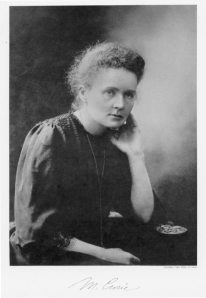Marie Curie was een Poolse wetenschapper die onderzoek deed naar radioactiviteit.
Het onderzoek dat Marie Curie uitvoerde heeft haar twee Nobel prijzen opgeleverd.
In 1903 ontving Marie Curie de Nobelprijs voor natuurkunde samen met haar man Pierre Curie en Henri Becquerel.
Henri Becquerel voor:
“Voor zijn ontdekking van de spontane radioactiviteit.”
En Marie en Pierre Curie voor:
“Voor hun onderzoek naar de stralingsfenomenen ontdekt door Henri Becquerel.”
In 1911 ontving Marie Curie de Nobelprijs voor scheikunde.
President of the Royal Academy of Sciences, director of the National Library, E. W. Dahlgren spoke:
The Royal Academy of Sciences, at its meeting on 7 November this year, has decided to award the Nobel Prize in Chemistry 1911 Professor at the Faculty of Sciences in Paris, Madame Marie Sklodowska Curie “in recognition of the active part she has taken in the development of chemistry by the discovery of chemical elements radium and polonium-h, by determining the properties of radium and the isolation in pure metallic state of radium, and finally parses research combinations of this remarkable element.”
Citaat overgenomen (en vertaald) uit Les Prix Nobel (http://archive.org/details/lesprixnobel1911nobe)
Het element curium (Cm) en een eenheid voor radioactiviteit, de Curie, zijn vernoemd naar Marie en Pierre Curie.



